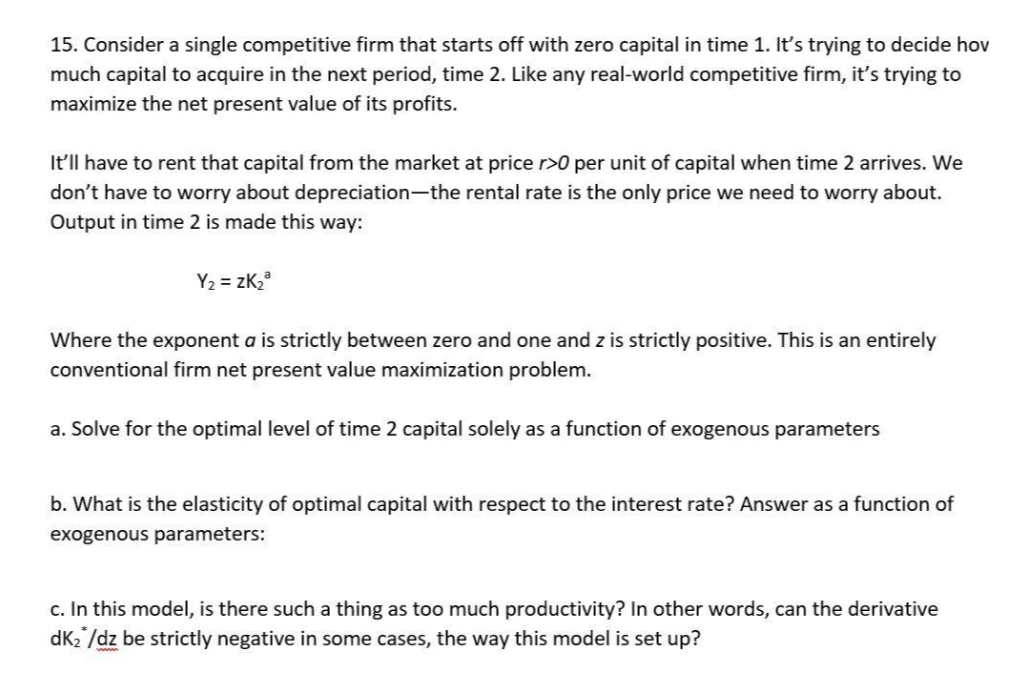15. Consider a single competitive firm that starts off with zero capital in time 1. It's trying to decide hov much capital to acquire in the next period, time 2. Like any real-world competitive firm, it's trying to maximize the net present value of its profits. It'll have to rent that capital from the market at price r>0 per unit of capital when time 2 arrives. We don't have to worry about depreciation-the rental rate is the only price we need to worry about. Output in time 2 is made this way: Y₂ = ZK₂² Where the exponent a is strictly between zero and one and z is strictly positive. This is an entirely conventional firm net present value maximization problem. a. Solve for the optimal level of time 2 capital solely as a function of exogenous parameters b. What is the elasticity of optimal capital with respect to the interest rate? Answer as a function of exogenous parameters: c. In this model, is there such a thing as too much productivity? In other words, can the derivative
15. Consider a single competitive firm that starts off with zero capital in time 1. It's trying to decide hov much capital to acquire in the next period, time 2. Like any real-world competitive firm, it's trying to maximize the net present value of its profits. It'll have to rent that capital from the market at price r>0 per unit of capital when time 2 arrives. We don't have to worry about depreciation-the rental rate is the only price we need to worry about. Output in time 2 is made this way: Y₂ = ZK₂² Where the exponent a is strictly between zero and one and z is strictly positive. This is an entirely conventional firm net present value maximization problem. a. Solve for the optimal level of time 2 capital solely as a function of exogenous parameters b. What is the elasticity of optimal capital with respect to the interest rate? Answer as a function of exogenous parameters: c. In this model, is there such a thing as too much productivity? In other words, can the derivative
Chapter11: The Firm: Production And Costs
Section: Chapter Questions
Problem 3P
Related questions
Question
10

Transcribed Image Text:15. Consider a single competitive firm that starts off with zero capital in time 1. It's trying to decide hov
much capital to acquire in the next period, time 2. Like any real-world competitive firm, it's trying to
maximize the net present value of its profits.
It'll have to rent that capital from the market at price r>0 per unit of capital when time 2 arrives. We
don't have to worry about depreciation-the rental rate is the only price we need to worry about.
Output in time 2 is made this way:
Y₂ = ZK₂³
Where the exponent a is strictly between zero and one and z is strictly positive. This is an entirely
conventional firm net present value maximization problem.
a. Solve for the optimal level of time 2 capital solely as a function of exogenous parameters
b. What is the elasticity of optimal capital with respect to the interest rate? Answer as a function of
exogenous parameters:
c. In this model, is there such a thing as too much productivity? In other words, can the derivative
dk₂/dz be strictly negative in some cases, the way this model is set up?
Expert Solution
This question has been solved!
Explore an expertly crafted, step-by-step solution for a thorough understanding of key concepts.
Step by step
Solved in 4 steps with 4 images

Knowledge Booster
Learn more about
Need a deep-dive on the concept behind this application? Look no further. Learn more about this topic, economics and related others by exploring similar questions and additional content below.Recommended textbooks for you

Exploring Economics
Economics
ISBN:
9781544336329
Author:
Robert L. Sexton
Publisher:
SAGE Publications, Inc

Principles of Economics 2e
Economics
ISBN:
9781947172364
Author:
Steven A. Greenlaw; David Shapiro
Publisher:
OpenStax

Exploring Economics
Economics
ISBN:
9781544336329
Author:
Robert L. Sexton
Publisher:
SAGE Publications, Inc

Principles of Economics 2e
Economics
ISBN:
9781947172364
Author:
Steven A. Greenlaw; David Shapiro
Publisher:
OpenStax